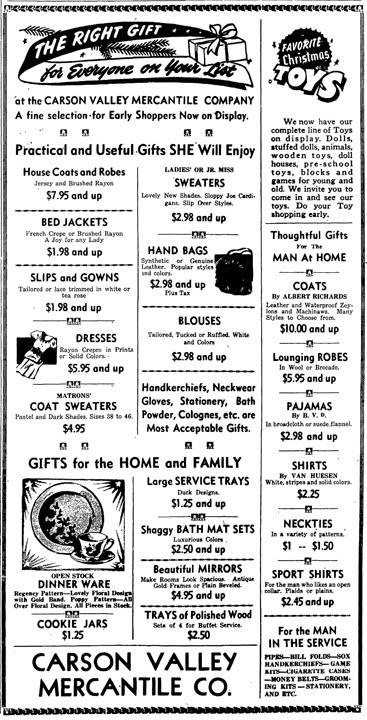The Backstory to the Cheshire Antiques Building!
As we saw in the last story, Arendt Jensen built what’s now the arched-window portion of Cheshire Antiques. Ground was broken in August 1906, and Jensen hired Reno builders to erect what was initially described as a “warehouse” some 50 x 100 feet in size. Brick for the project came from a kiln near Minden.

But turns out it wasn’t actually a warehouse that Jensen was building. Instead, the Record-Courier announced on February 8, 1907 that Jensen’s new store was expected to open within the next sixty days. With 7,800 square feet of floor space (thanks to an interior mezzanine), it was touted as the “largest to be erected for a like purpose in Nevada in a town the size of Gardnerville” and promised to be “a large department store.”
This wasn’t Jensen’s first retail establishment, of course; it was actually his third Gardnerville location since Jensen and his wife moved to town in 1887. So by the time this new brick building went up, Jensen was a prosperous merchant.
The new A. Jensen store featured all the latest gadgets, including “automatic cash carriers” (possibly a pneumatic tube system) and a freight elevator for hauling heavy merchandise up to the mezzanine level. The Jensen store also carried a “wilderness of merchandise”: dry goods, groceries, plus general merchandise including hardware, tinware, clothing and even wagons. Jensen officially incorporated as Arendt Jensen Co. in 1908, with his advertisements proudly proclaiming the new business name.

As early as 1906, a separate building just to the south housed “agricultural implements” for Jensen’s store.

As the “exclusive Studebaker dealer” in town, Jensen sold both Studebaker wagons and automobiles. In 1909, he advertised the new “30” model, which “glides along” and is “almost noiseless.”


But in 1910, after more than twenty years in business, Jensen had grown tired of 14- to 18-hour days. He sold his company to Peter Christensen, Earl Christensen, and Chris Neddenriep, and “retired” to pursue his latest passion — banking.
The mercantile business continued to be known as A. Jensen Co., and over the next decade saw “remarkable growth.” The new owners replaced the roof in 1917 and also scrapped the freight elevator to make room for a new brick cellar. In 1920, they leased the ground floor of the newly-built Masonic Lodge building next door for their hardware and machinery department. By 1921, a machine shop was also being operated in the rear by Adolph Rohlfe, who built one-man scrapers and performed custom blacksmithing. (Locals remember a later machine shop just down the street, where DST Coffee stands today.)
A sea change of sorts took place in 1933, when Chris Neddenriep bought out his two partners and renamed the business the Carson Valley Mercantile. Soon, it was known affectionately by everyone in town as simply the “Merc.”

As for Arendt Jensen, the Great Depression cratered his heavy investments in cattle, sheep, and ranches in Smith Valley and near Sweetwater. Forced to sell his bank, Jensen retired to his farm near Gardnerville, operating a dairy for a few years. When Jensen died in 1940 at the age of 81, his contribution to the growth of Gardnerville was warmly remembered.
The mercantile business that he’d started lived on, though not without its challenges. In 1953, burglars broke in through a second-story window and made off with $1,000 and “considerable merchandise.” The store’s safe had been located downstairs and in the back. After that, as a precaution it was moved to the front window on the hardware side, “in view of large windows and under a night light.” Even so, the safe was cracked again in 1956, although the loss this time was just $100.
During the late 1960s, the Merc was operated by Luke Neddenriep, and Mush Parker operated a branch Western store inside. For a time, the portion to the right (under the Lodge) was operated as a Safeway, and later Max Jones had a store there. But eventually the Merc expanded into this side, as well.
Locals still have happy memories of shopping at the Merc. “You could find everything you needed at the Merc; they were a one-stop shop,” one Carson Valley native fondly recalls. “They had groceries, a wonderful butcher shop on the taller part of the two buildings. On the left was a great hardware department. Clothing was on the main floor, too. Upstairs were household items and toys. When we were kids, my friends and I would bring soda bottles in for the deposit money, and buy [comic] books and records.”
“When I went inside, it felt so serene, back in time when [life] wasn’t so complicated,” another long-time resident reminisces. And the Merc is still remembered as a favorite place for Christmas shopping, with gifts for every family member on your list.

But by 1974, the business owed $739 in taxes on their Main Street lot. Things weren’t going well. An advertisement in January 1976 “look[ed] forward to a better year.” But it was not to be. Just two months later, the Merc was announcing a 50% off clearance sale.
NAPA Auto Parts moved into the old Carson Valley Merc building several years later, and in 1982 it became Penguin Plumbing.
In January, 2005, Karen and Richard Campbell leased the old Jensen store building for Cheshire Antiques. And five months later, they were able to expand into the adjacent space.
What a perfect place for an antique store, in such a historic building! We can only imagine Arendt Jensen would be proud.
